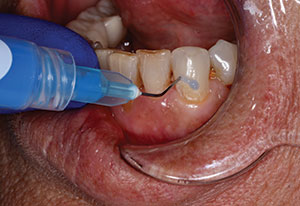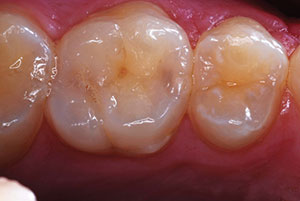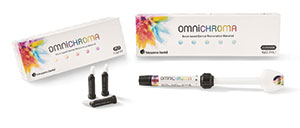INTRODUCTION
It is foolish to think that all technology is suited for all practices. Despite what sales representatives say about any expensive technology being able to “put the joy back into practice,” clinical happiness can only be a result of efficiently done, long-lasting services that please patients.1 Technology such as digital impressions and in-office CAD/CAM restorations can be an awesome practice enhancement when the results are consistent and long-lasting.
This practitioner has placed more than 10,000 single-appointment, in-office CAD/CAM restorations. All dentists have been challenged throughout the years with porcelain fractures, debonding, tooth failure around conservative restorations, microleakage, and less-than-ideal aesthetics since first using the CEREC 2 (Dentsply Sirona) in 1999.2 In the earlier years of this digital technology, software and hardware limitations resulted in tooth morphology that looked less than natural; however, we now have restorations that are aesthetically pleasing and while also demonstrating excellent clinical performance.3
There has been significant improvement in digital systems, restorative materials, preparation parameters and philosophy, and cementation techniques.4 The long-term clinical performance and office efficiency are vastly improved because of lithium disilicate, universal bonding agents, and dual-cure self-adhesive resin cements; these innovative dental materials have become the cornerstones of CAD/CAM success that have supported our stated goal of simple excellence.
CASE REPORT
Diagnosis and Treatment Planning
A patient was referred to our office by an endodontist because of a suspected fracture in tooth No. 30 (Figure 1). She had been avoiding chewing on the lower right side because of occasional sharp pain and cold sensitivity.5 There were no radiographic or clinical signs of irreversible pulpitis: no spontaneous pain, no lingering pain to thermal testing, no apical radiolucency. However, there were significant recurrent and interproximal caries. Tooth brushing and any touching on the mesial facial recession area resulted in pain. Both buccal cusps elicited a sharp “zinging” pain when loaded with a Tooth Slooth II (Professional Results).
Cracked tooth syndrome can be an elusive diagnosis and may have a variety of potential treatments including endodontics, extraction, and direct or indirect restorative dentistry.6 The plan was for the removal of decay and the placement of a full-coverage restoration (monolithic lithium disilicate) to alleviate the symptoms and to also reduce the potential for any further crack propagation.
Preparation Protocol
Care must always be taken to reduce iatrogenic pulpal irritation with sharp concentric burs that will also minimize any undue heat buildup. A new single-use 330 carbide bur (NeoBurr [Microcopy]) was used for depth cuts and to make interproximal slices. A 330 carbide bur cuts very efficiently with minimal heat buildup and vibration, while the length of its cutting head (1.5 to 2.0 mm, depending on the manufacturer) makes an excellent depth cut down the central fossa and over and through each cusp tip (Figure 2).
Existing restorations and decay were removed and verified with a caries indicator solution (Sable Seek [Ultradent Products]). The full-coverage tooth preparation was then completed using a new single-use tapered diamond bur (NeoDiamond, No. 1112.10 [Microcopy]) (Figure 3). It must be stressed that, in the pursuit of long-term patient comfort, the single-use, high-quality, low-heat-causing burs are a real benefit. The cost of single-use burs is comparatively low and yet the positive effects may be dramatic.
 |
 |
| Figure 1. Tooth suspected of cracked tooth syndrome with existing fillings, sensitivity, and recurrent decay. | Figure 2. Depth and interproximal cuts were done with a single-use 330 bur (NeoBurr [Microcopy]). |
 |
 |
| Figure 3. A tapered diamond (NeoDiamond, No. 1112.10 [Microcopy]) was used to complete the preparation for a lithium disilicate restoration. | Figure 4. The areas of decay and fillings were prepared into the retention form of the restoration and most undercuts removed. |
The basic preparation for a monolithic lithium disilicate calls for an anatomic preparation that has 4° to 8° of axial taper and 3.0 mm (minimum) to 4.0 mm axial wall height (for proper retention and resistance form); a 1.0- to 1.5-mm rounded shoulder or chamfer margin; and 1.0- to 1.5-mm occlusal clearance.7 All the line angles must be rounded, and the margins should be smooth, continuous, and of consistent depth (Figure 4).
Notice a few important aspects of the preparation for digital CAD/CAM dentistry. First, the margins should be placed on supragingival enamel, whenever possible. This helps with digital impression capture, isolation during cementation, and also allows for easier cleanup of the luting cement. Placing margins in enamel also reduces the chances for microleakage from marginal contamination that can lead to sensitivity and long-term failure. In this case, the only places that approach the gingiva are to cover the extent of interproximal decay and to cover the facial recession-sensitivity area.
Also note that the areas of decay and old restorations were prepped into the retention form of the restoration without doing buildups in this case. The additional surface area and divergent parallel walls increase retention and lessen the need to drill more of the tooth toward the gingiva in an attempt to increase retention (Figure 5). This practitioner feels strongly that preparation margins should be placed subgingivally rarely, and only when required by aesthetic needs, the presence of decay, or the need for retention.
Digital Scanning Technology
This practitioner has used the CEREC system (Dentsply Sirona) since 1999 and has seen a wide variation in clinical success after more than 10,000 single-visit restorations. Materials and techniques have been refined and improved with time, providing systems that consistently result in a very high degree of clinical success.
 |
 |
| Figure 5. Preparations for monolithic lithium disilicate restorations require an occlusal clearance of 1.0 mm (minimum) to 1.5 mm with smooth flowing margins at 1.0 to 1.5 mm. | Figure 6. The CEREC Omnicam (Dentsply Sirona) has a very accurate digital impression system and very user-friendly software. |
The CEREC Omnicam (Dentsply Sirona) was used to capture digital images and to design the restoration (Figure 6). The upper and lower right quadrants were captured along with the occlusion. Next, the margins were manually traced and then the computer software designed the crown using surrounding anatomy and a library of morphologic information. The occlusion is reliably accurate from digital capture of the bite. In the majority of cases, the proposal needs very little modification.
Preparing the Restoration
Lithium disilicate has proven to be a very successful posterior restorative material due to its strength, fracture toughness, and natural aesthetics when proper preparation and cementation guidelines are followed. The software shows the position of the restoration inside the lithium disilicate block (IPS e.max CAD [Ivoclar Vivadent]) and the milling of the restoration in this case was done in about 9 minutes (Figure 7). The noncrystallized state (often referred to as the “blue block”) is an unhardened form of the material that is easier to mill (Figure 8). In this case, the assistant removed the sprue, tried in the restoration, verified fit, and then made any needed adjustments (Figure 9).
 |
 |
| Figure 7. The lithium disilicate “blue block” (IPS e.max CAD [Ivoclar Vivadent]) is shown and the position of the restoration within it along with the sprue location. | Figure 8. The precrystallized form is softer and easier to mill. |
 |
 |
| Figure 9. After sprue removal, the marginal fit, contacts, and occlusion were verified. | Figure 10. The milled restoration was then placed on a firing tray where stain and crystallization spray were applied. |
 |
 |
| Figure 11. After time in the oven, the fixation putty was removed and etched with hydrofluoric acid and then silanated. | Figure 12. The bond of the self-adhesive dual-cure resin cement (Bifix SE [VOCO America]) is enhanced by a universal bonding agent (Futurabond U [VOCO America]). |
The lithium disilicate restoration was then secured to a firing tray pin with a putty (Object Fix [Ivoclar Vivadent]), customized with some copper and white stains, sprayed with a crystallization glaze (Glaze Spray [Ivoclar Vivadent]), and placed in a firing oven for about 16 minutes. This process creates excellent hardness and flexural strength/fracture toughness while revealing the true basic shade (as chosen chairside to match the patient’s teeth) (Figure 10). After divestment, cleaning, and a patient try-in, 4% hydrofluoric acid was placed on the internal surfaces of the restoration for 20 seconds and then rinsed thoroughly with water, resulting in a frosty surface (Figure 11). Silane (BIS-SILANE Unhydrolyzed [BISCO Dental Products]) was then placed and allowed to evaporate for about 60 seconds then air-dried.
Universal Bonding Protocol
While it is true that lithium disilicate (IPS e.max) can be cemented with a “conventional” cement (ie, a glass ionomer or resin-reinforced glass ionomer), or bonded into place using an adhesive system and a resin luting cement, the author’s office adhesively bonds almost all lithium disilicate restorations to optimize aesthetics, material strength, and long-term retention. The author has witnessed a significantly higher fracture rate of lithium disilicate after 5 to 7 years for those conventionally cemented versus those placed with a bonded dual-cure resin.
Self-adhesive resin cements (such as RelyX Unicem [3M], SpeedCEM Plus [Ivoclar Vivadent], BisCem [BISCO Dental Products], SmartCem 2 [Dentsply Sirona], and Bifix SE [VOCO America], to name a few) have become widely accepted for indirect adhesive cementation because of their simplicity and good retention. When the preparation includes excellent resistance and retention form, and a proper isolation protocol is employed, these cements are an acceptable choice. However, the chemistry inside these “self-adhesive” resins is less than using a separate bonding system.8
The bond of self-adhesive resin cements is significantly stronger to etched and silanated lithium disilicate than to the dentin or enamel, and any failures are normally found at the cement-tooth interface.9 Microleakage and subsequent failures of dual-cure resin cements are improved by using the superior chemistry of a separate adhesive system. As a result, that has been the predominant method of cementation for single-visit indirect restorations that has become associated with greater clinical success.10
In the author’s office, self-adhesive resin cement is used along with a universal dentin bonding agent when retention is suspect, excessive occlusal forces might be expected, or sensitivity control is critical. Futurabond U (VOCO America) has proven to be an excellent dentin bonding agent.11 The “universal” category of bonding agents means high bond strengths regardless of etch technique used, be it a total-, self-, or selective-etch technique. This particular material has a patented SingleDose packaging system that ensures ideal solvent concentrations and is versatile enough for all adhesive dentistry while being cost effective. Because it is dual-cure adhesive with a very low film thickness, it is a great choice to use on the tooth before a dual-cure resin or before a self-adhesive dual-cure resin.
 |
 |
| Figure 13. Futurabond U is a dual-cure bonding agent that has a higher bond to enamel and dentin than the self-adhesive luting materials. | Figure 14. The universal bonding agent was massaged onto the tooth. |
 |
 |
| Figure 15. Air-thinning was done to remove the solvent and to lessen the film thickness. | Figure 16. There is a high bond strength with self-adhesive resin to etched and silanated lithium disilicate. |
 |
 |
| Figure 17. Cleanup was done using Bifix SE. | Figure 18. Adjustments were done with a finishing diamond (No. 3314.10 [Microcopy]), then the restoration was polished to a high gloss with rubber points. |
Bifix SE is an excellent representative in the self-adhesive resin cement category and is ideal for CAD/CAM dentistry due to its excellent aesthetics, easy cleanup, and good adhesion. Using Bifix SE alone for cementation on preps with good retention produces predictable long-term results as compared to other self-adhesive resin cements.12 By using the Futurabond U first on the tooth, long-term bonds are increased to both dentin and unetched enamel (Figure 12).13
The tooth was isolated with a Dentapop (Dentapop) and a Dry Tip (Mölnlycke Health Care). Next, the Futurabond U was activated by pressing and squeezing the indicated location on the SingleDose packaging. The material was then accessed by breaking the protective foil with the microbrush (Figure 13). After immersion in the material, the microbrush was massaged onto the tooth and blown with air, resulting in a thin layer and a shiny dentin surface (Figures 14 and 15). The Bifix SE was then placed into the crown and seated onto the tooth (Figure 16).
Despite the fact that this luting material is dual-cure, we allowed the chemical cure to take place while cleaning up excess cement for more than a 2- to 3-minute period. After flossing and scaling, the margins were light-cured (Elipar [3M]). This sequence allows for maximal polymerization conversion of the material and margin stability (Figure 17). The bite was checked and any needed occlusal adjustments were done using a high-speed finishing diamond (No. 3314.10 bur [Microcopy]) with light pressure and copious water. Lastly, the restoration was polished (CeraMaster [Shofu Dental]) (Figure 18).
CLOSING COMMENTS
With the suspicion of having a cracked tooth, the patient in this case was made aware of the potential for future endodontic care and even the possibility of a future extraction (Figure 19).
 |
 |
| Figure 19. The restoration should provide symptom-free service. | Figure 20. The completed lithium disilicate restoration. |
The goal of the restorative procedures is to maximize the chances of long-term success and to achieve a satisfied patient experience. Using the materials and procedures as described in this clinical case report helps to maximize the potential of that happening (Figure 20). As of the writing of this article, at about 22 to 23 months, a symptom-free result had been reported.
References
- Levine N. To the sky and beyond. Dental Products Report. October 2009:116.
- Otto T, De Nisco S. Computer-aided direct ceramic restorations: a 10-year prospective clinical study of Cerec CAD/CAM inlays and onlays. Int J Prosthodont. 2002;15:122-128.
- Reiss B, Walther W. Clinical long-term results and 10-year Kaplan-Meier analysis of Cerec restorations. Int J Comput Dent. 2000;3:9-23.
- Fasbinder DJ. Clinical performance of chairside CAD/CAM restorations. J Am Dent Assoc. 2006;137(suppl):22S-31S.
- Türp JC, Gobetti JP. The cracked tooth syndrome: an elusive diagnosis. J Am Dent Assoc. 1996;127:1502-1507.
- Hasan S, Singh K, Salati N. Cracked tooth syndrome: overview of literature. Int J Appl Basic Med Res. 2015;5:164-168.
- Ivoclar Vivadent. All-ceramic: chairside preparation guide for IPS Empress and IPS e.max. ivoclarvivadent.us/empress/documents/all_ceramic_prep_guide.pdf. Accessed July 25, 2016.
- Ritter AV, Ghaname E, Pimenta LA. Dentin and enamel bond strengths of dual-cure composite luting agents used with dual-cure dental adhesives. J Dent. 2009;37:59-64.
- Naranjo J, Ali M, Belles D. Comparison of shear bond strength of self-etch and self-adhesive cements bonded to lithium disilicate, enamel and dentin. Tex Dent J. 2015;132:914-921.
- Lührs AK, Guhr S, Günay H, et al. Shear bond strength of self-adhesive resins compared to resin cements with etch and rinse adhesives to enamel and dentin in vitro. Clin Oral Investig. 2010;14:193-199.
- Rocha Gomes Torres C. Clinical evaluation of direct and indirect composite restorations using the chaired technique. Universidad Estadual Paulista Julio de Mesquita Filho, Sao Jose dos Campos, Sao Paulo, 2015.
- Raimondi CJ, Jessup JP, Ashcraft-Olmscheid D, et al. Bond strength of resin cements to dentin using universal bonding agents. Am J Dent. 2016;29(3):175-179.
- Rosa WL, Piva E, Silva AF. Bond strength of universal adhesives: A systematic review and meta-analysis. J Dent. 2015;43(7):765-76. Epub Apr 15, 2015.
Dr. Griffin completed a general practice residency and maintains a general practice in Eureka, Mo. He focuses his clinical efforts on efficiency in almost all phases of general dentistry while providing state-of-the-art care and services for affordable fees. He centers his teaching content on increasing practice efficiency and on predictable restorative dentistry techniques. He can be reached via email at jgriffinjrdmd@gmail.com or via the website eurekasmile.com.
Disclosure: Dr. Griffin reports no disclsoures.
Related Articles
Finally, a Real Change in Dental Local Anesthesia
Nanoceramic CAD/CAM Restorations
CAD/CAM Restorative Principles











